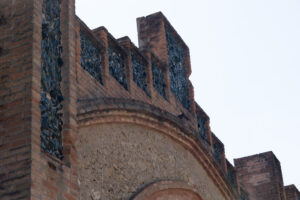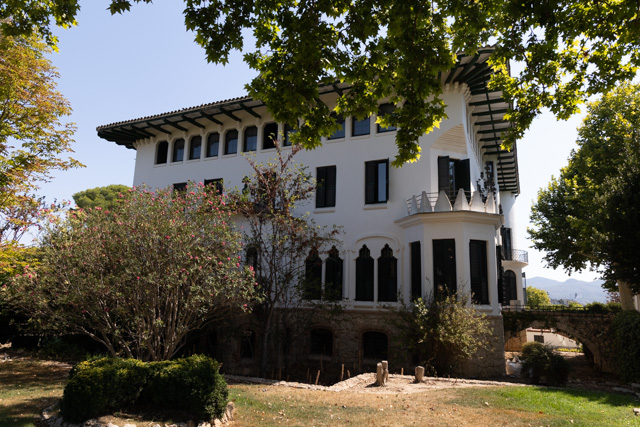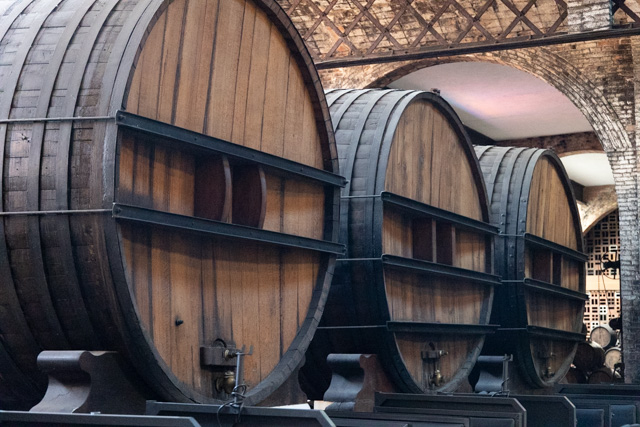“So is champagne really that much better than cava?”
It was, of course, the obvious question to ask.
Alec, who had just given us a most fascinating tour of the oldest cava winery in Spain, paused mid-way through pouring out a third glass of Codorníu Gran Cremant, 2021 vintage.

Cava is made using the same method as is used in the production of champagne. Indeed, until the 1970s, what is now known as cava was actually sold under the label of champagne. This was before champagne secured legally protected status under European law. The Codorníu winery still displays old posters that advertises champagne from the winery.
“Cava means ‘cave’, which is where the aging of the wine used to take place,” said Alec. “It’s a bit easier to pronounce than champagne.”
I couldn’t help but feel that this might be part of the problem. I wasn’t entirely certain that connoisseurs of fine wine particularly cared for names that were easy to pronounce. They wanted exotic names and spoke of sophistication.
Despite the champenoise method being used in the production of cava, there are some important distinctions between the two different types of bubbly.
The type of grapes used, for one thing. The main varieties used in champagne production are pinot noir, pinot meunier and chardonnay, while cava typically uses a blend of parellada, xarel-lo and macabeo.
The climate is different in the Champagne region of France than in Catalonia, where most of Spain’s cava production come from. These differences result in a slightly different taste profile of the two types of bubbly, with cava typically having a lower acidity content than champagne.
While everyone’s taste preferences are different, one can’t ignore the fact that champagne owes a lot of its success to clever marketing and branding campaigns.
“You can buy a decent bottle of cava in Spain for €5 or €10, but you can easily pay €40 or €50 for a similar quality bottle of champagne,” said Alec.
Indeed the bottle of cava that we were sampling – not the most sophisticated in the Codorníu range but eminently drinkable all the same – retails at a little more than €5 in Spain, making it a very affordable tipple.
Come for the history – and the architecture
“This is the oldest winery in Spain,” our guide proudly declared at the start of the tour.
Codorníu was founded in 1551, although the first bottles of cava weren’t produced until the 19th century. Cava now owns 15 wineries. Two of these are outside of Spain; one in California’s Napa Valley and the other in Argentina.
Wandering around the Codorníu winery, one really gets a sense of the journey that it has taken through history.
To our left stood the sparkling new cava production centre, loaded with the latest technology (no more painful turning of the bottles by hand) and using steel containers for aging rather than oak barrels (“better for regulating the temperature”, our guide told us).
To the right loomed the old production centre, dark and brooding like some neglected schoolhouse that can no longer find a place in modern world. This building is not used any more for the production of cava, although it does have other uses. It is quite a popular place to get married, for example – and it is where visitors get taken to get a glimpse into cava’s rich history.

At first glance, the old production centre looks like any other factory building, built of uninspiring brick with broad arched windows. However, as one looks up, one notices that the brickwork is fringed with broken glass bottles.
“This is the same technique that you’ll see on the dragon scales of Gaudi’s Casa Batlló,” said Alec. Anyone that has taken a tour of Gaudi’s masterpieces in the centre of Barcelona will understand what he meant.
I hadn’t really expected to encounter the kind of modernism that Barcelona has become so well known for while exploring one of Catalonia’s wineries.
“To promote the image of Codorníu, Manuel Raventós [who took over the running of the winery in 1885] hired one of the greatest architects of Catalan modernism, Josep Puig i Cadafalch,” said Alec. “So the buildings aren’t just functional. They’re nice to look at, too.”
Puig designed three buildings on the Codorníu grounds: the building that now serves as a reception area and tasting room (which looks very much like an old cathedral), the old production building and the former residence of the Raventós family.
Once we had enjoyed our fill of modernist architecture, it was on to the old underground wine cellars: 19 miles of them! Of course we only got to see a small part of them, but the atmosphere oozed with history. The dimly-lit corridors were lined with old bottles, still filled with cava (presumably undrinkable now) in order to lend that added bit of authenticity.
For those that get the chance to see the old cavas, there is an electric train that whisks visitors through the low-ceilinged tunnels. This was certainly one of the highlights of the tour – at least for the kids!
And then it was on to the tasting – the highlight, of course, for the adults.

Other cava wineries
Codorníu is not the only producer of cava in the region, and if you are interested in the wine it is definitely worth visiting one or two of the others.
Most cava producers are located in the El Penedès region of Catalunya, which is about a 45-minute drive northwest of Barcelona. Some cava is produced outside of Catalunya, though, in places such as La Rioja, Aragón, Valencia and Extremadura. The important thing is that all producer have a “denominación de origen” certificate, which authenticates the methods use and the quality of the cava.
Other cava wineries in the region that welcome visitors are:
- Freixenet – another iconic cava producer, known for its large-scale production and international recognition.
- Recaredo – a family-owned winery founded in 1924, famed for its brut nature cava.
- Vilarnau – producing cavas since 1949, this winery prides itself in artisanal cultivation techniques. Higher altidtudes contribute to a slower maturation of the grape.
- Alta Alella – the closest winery to Barcelona, with vineyards that drop down to the sea.
- Llopart – an organic wine producer, sporting a vineyard with lovely mountain views.
- Gramona – blends innovation with tradition, priding itself on pushing new boundaries in the development of new cava varieties.
- Castellroig – a small organic producer, offering a more personal and less commercial wine-tasting visit.
All of these wineries are happy to arrange tours. You can check their websites for more details – including how to book. All of them offer slightly different experiences.
Getting to the wineries is easy if you have car – although of course, if you do decide to drive yourself, you will then be limited to the amount of wine-tasting you can do.
An alternative way of exploring the region is to take a taxi instead, although this is likely to be a more expensive option. You should mention what wineries you want to visit, and expected waiting time at each one, before you set off in order to negotiate a convenient price.
The final option is to join an organised tour. Several companies in Barcelona organise these. The Penedès Tourist Board provides details of tours that are available. It also offers advice of what else there is to do in the region, besides just sampling the local wine.
